The AMD Ryzen Threadripper 3960X and 3970X Review: 24 and 32 Cores on 7nm
by Dr. Ian Cutress, Andrei Frumusanu & Gavin Bonshor on November 25, 2019 9:05 AM ESTCPU Performance: System Tests
Our System Test section focuses significantly on real-world testing, user experience, with a slight nod to throughput. In this section we cover application loading time, image processing, simple scientific physics, emulation, neural simulation, optimized compute, and 3D model development, with a combination of readily available and custom software. For some of these tests, the bigger suites such as PCMark do cover them (we publish those values in our office section), although multiple perspectives is always beneficial. In all our tests we will explain in-depth what is being tested, and how we are testing.
All of our benchmark results can also be found in our benchmark engine, Bench.
Application Load: GIMP 2.10.4
One of the most important aspects about user experience and workflow is how fast does a system respond. A good test of this is to see how long it takes for an application to load. Most applications these days, when on an SSD, load fairly instantly, however some office tools require asset pre-loading before being available. Most operating systems employ caching as well, so when certain software is loaded repeatedly (web browser, office tools), then can be initialized much quicker.
In our last suite, we tested how long it took to load a large PDF in Adobe Acrobat. Unfortunately this test was a nightmare to program for, and didn’t transfer over to Win10 RS3 easily. In the meantime we discovered an application that can automate this test, and we put it up against GIMP, a popular free open-source online photo editing tool, and the major alternative to Adobe Photoshop. We set it to load a large 50MB design template, and perform the load 10 times with 10 seconds in-between each. Due to caching, the first 3-5 results are often slower than the rest, and time to cache can be inconsistent, we take the average of the last five results to show CPU processing on cached loading.
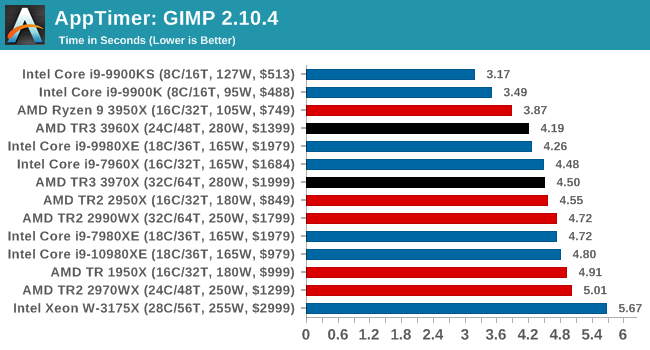
Onto our single threaded tests, and the mainstream hardware with high single thread frequencies wins here, but the 3960X is leading the rest of the pack. Intel's 28-core part here sits last, behind even the 1950X.
3D Particle Movement v2.1: Brownian Motion
Our 3DPM test is a custom built benchmark designed to simulate six different particle movement algorithms of points in a 3D space. The algorithms were developed as part of my PhD., and while ultimately perform best on a GPU, provide a good idea on how instruction streams are interpreted by different microarchitectures.
A key part of the algorithms is the random number generation – we use relatively fast generation which ends up implementing dependency chains in the code. The upgrade over the naïve first version of this code solved for false sharing in the caches, a major bottleneck. We are also looking at AVX2 and AVX512 versions of this benchmark for future reviews.
For this test, we run a stock particle set over the six algorithms for 20 seconds apiece, with 10 second pauses, and report the total rate of particle movement, in millions of operations (movements) per second. We have a non-AVX version and an AVX version, with the latter implementing AVX512 and AVX2 where possible.
3DPM v2.1 can be downloaded from our server: 3DPMv2.1.rar (13.0 MB)
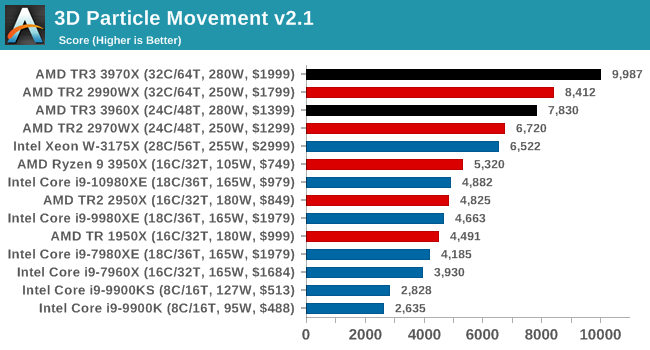
With non-AVX, AMD's floating point units put on a great performance.

This is a workload that can be AVX512 accelerated, and this is the main instance where we can see Intel's CPUs having an advantage.
Dolphin 5.0: Console Emulation
One of the popular requested tests in our suite is to do with console emulation. Being able to pick up a game from an older system and run it as expected depends on the overhead of the emulator: it takes a significantly more powerful x86 system to be able to accurately emulate an older non-x86 console, especially if code for that console was made to abuse certain physical bugs in the hardware.
For our test, we use the popular Dolphin emulation software, and run a compute project through it to determine how close to a standard console system our processors can emulate. In this test, a Nintendo Wii would take around 1050 seconds.
The latest version of Dolphin can be downloaded from https://dolphin-emu.org/
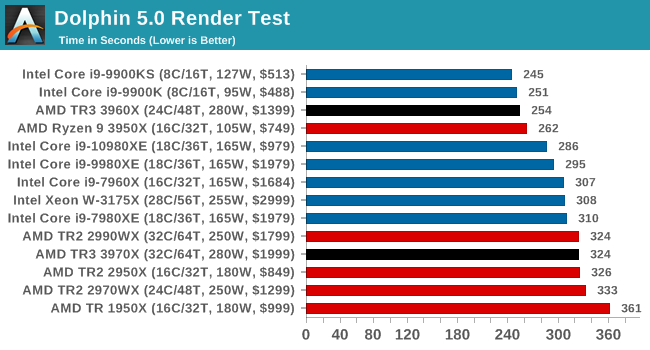
On the single threaded workloads again, and the high frequency mainstream CPUs win here. Interestingly, the 3960X also puts on a really good show, and actually beats our 3950X. Interesting.
DigiCortex 1.20: Sea Slug Brain Simulation
This benchmark was originally designed for simulation and visualization of neuron and synapse activity, as is commonly found in the brain. The software comes with a variety of benchmark modes, and we take the small benchmark which runs a 32k neuron / 1.8B synapse simulation, equivalent to a Sea Slug.
Example of a 2.1B neuron simulation
We report the results as the ability to simulate the data as a fraction of real-time, so anything above a ‘one’ is suitable for real-time work. Out of the two modes, a ‘non-firing’ mode which is DRAM heavy and a ‘firing’ mode which has CPU work, we choose the latter. Despite this, the benchmark is still affected by DRAM speed a fair amount.
DigiCortex can be downloaded from http://www.digicortex.net/
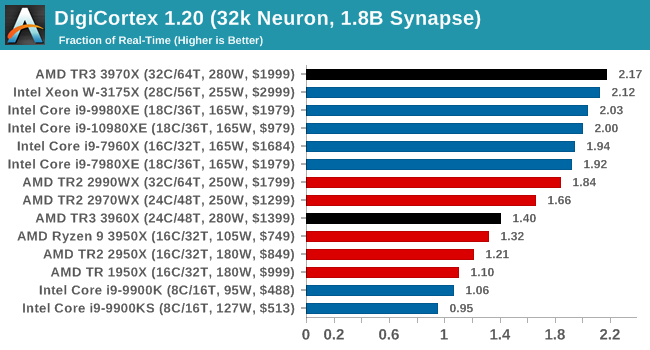
I'm surprised there's that much difference between the 3970X and 3960X here, especially with the 3960X sitting behind the TR2 processors. Might have to re-run this one to double check. But the 3970X puts out a commanding lead.
y-Cruncher v0.7.6: Microarchitecture Optimized Compute
I’ve known about y-Cruncher for a while, as a tool to help compute various mathematical constants, but it wasn’t until I began talking with its developer, Alex Yee, a researcher from NWU and now software optimization developer, that I realized that he has optimized the software like crazy to get the best performance. Naturally, any simulation that can take 20+ days can benefit from a 1% performance increase! Alex started y-cruncher as a high-school project, but it is now at a state where Alex is keeping it up to date to take advantage of the latest instruction sets before they are even made available in hardware.
For our test we run y-cruncher v0.7.6 through all the different optimized variants of the binary, single threaded and multi-threaded, including the AVX-512 optimized binaries. The test is to calculate 250m digits of Pi, and we use the single threaded and multi-threaded versions of this test.
Users can download y-cruncher from Alex’s website: http://www.numberworld.org/y-cruncher/
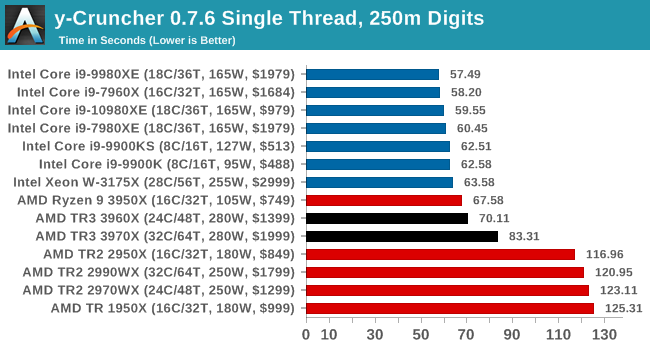
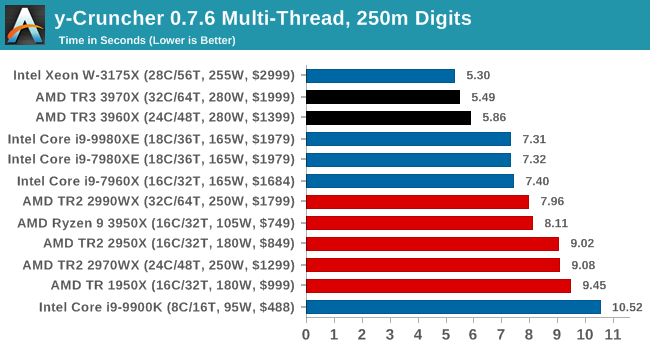
y-Cruncher is also AVX-512 accelerated, however when all the 32 threads come together in MT mode on AVX2, having that many pushes through 18 cores with AVX-512.
Agisoft Photoscan 1.3.3: 2D Image to 3D Model Conversion
One of the ISVs that we have worked with for a number of years is Agisoft, who develop software called PhotoScan that transforms a number of 2D images into a 3D model. This is an important tool in model development and archiving, and relies on a number of single threaded and multi-threaded algorithms to go from one side of the computation to the other.
In our test, we take v1.3.3 of the software with a good sized data set of 84 x 18 megapixel photos and push it through a reasonably fast variant of the algorithms, but is still more stringent than our 2017 test. We report the total time to complete the process.
Agisoft’s Photoscan website can be found here: http://www.agisoft.com/

New records for Photoscan as well.












245 Comments
View All Comments
Dizoja86 - Thursday, November 28, 2019 - link
"Intel is going to have to have a shift its design strategy to compete."im.thatoneguy - Tuesday, December 3, 2019 - link
Any temperature stats? You recommend a good water cooler so it would be helpful to know how the thermaltake ring did under load.cdb000 - Sunday, January 26, 2020 - link
Seconded!In fact, a good write-up on how to cool a 280W CPU that is continuously running flat out.
My (old, slow) 1950X is cooled by a 280mm AIO and gets to ~61C when run flat out. These new Threadrippers use 55% more power which suggests that a 420mm or 480mm radiator will be required.
pvrvideoman - Thursday, December 5, 2019 - link
Great for AMD! Popular YouTube tech reviewers and others really need to stop saying that AMD has "crushed" Intel. That is just stupid. What they have done is deliver a very powerful, competitively priced product that delivers mostly the same or better performance at different price points. The desktop market is small. It's not making AMD or Intel all that much money. But it is great when companies like Amazon and Google talk about moving forward or transitioning to AMD Epyc line of processors. The enterprise and High Performance Computing contracts are where the real victory lies.tamalero - Tuesday, December 24, 2019 - link
holy intel apologist batman..alpha754293 - Monday, December 16, 2019 - link
When are the results from the benchmarking for the AMD Threadripper 3970X going to be on the benchmarking database?I tried looking for it just now and couldn't find it listed when I wanted to compare that and the AMD Ryzen 3950X.
Thanks.
lxxxxl - Thursday, December 19, 2019 - link
Is Chromium compilation still on the list of tests?And these new Threadrippers are not in Bench database?
soultorntech - Monday, December 23, 2019 - link
People concerned about the price between AMD and Intel HEDT processors need to calculate the per core cost and they will find out that the cost between the HEDT processors are pretty close. Add in the fact that Threadripper has a lot more L3 cache than the 10980XE plus can utilize up to 4 times as much RAM then the price of Threadripper 3 processors are a little easier to justify.stefanbatros - Sunday, December 29, 2019 - link
Hi everyone,I bought a 3970x + a Gigabyte Designare mobo. These will be used in a 4GPU setup for rendering and physics simulations.
Right now I have to chose between these 2 Ram kits, which are available and at a decent price in my country:
1. Corsair VENGEANCE® 128GB 3000MHz C16 -750$
2. G.Skill TridentZ 3000MHz C14 - 981$
Do you guys think that the C14 Gskill justifies the 200$ dollar difference? Will it be great improvement over the C16?
I am leaning toward the Vengence more because of price +is in stock in store + it is low profile and it will fit better with the Noctua nh-u14s tr4-sp3.
Any suggestions will ge appreciated.
Thanks,
Stefan
InfernusTitan - Friday, January 3, 2020 - link
A GTX 1080?Not Bottlenecking a 32 Core CPU in any ways??? I know core counts doesnt matter that much but still.